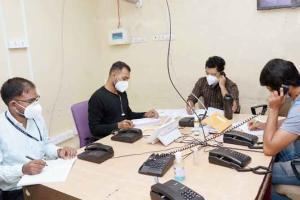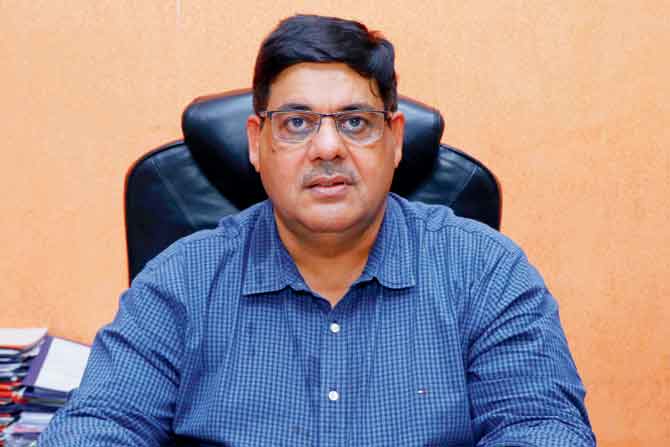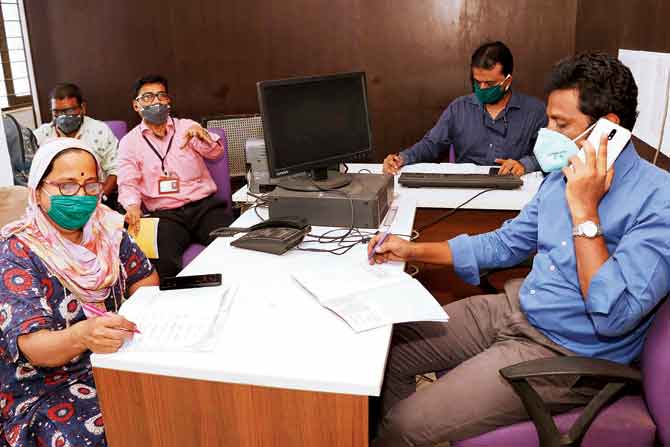
The M East ward war room has 21 people working in shifts attending over 100 calls a day. PICS/Rajesh Gupta
After Dharavi offered a beacon of hope in the fight against COVID-19, M East ward that constitutes Govandi and Mankhurd, and has a large slum population, has followed suit. While the fight is far from over, the ward, which was in the top three in the city for rising cases, is now at number 13 and the doubling rate here has also improved from eight to 10 days to 68 days. Over 300 volunteers were involved in high-risk contact tracing here.
According to ward officer Assistant Municipal Commissioner Sudhanshu Dwivedi, who is the force behind the successful curbing of COVID-19 here, intensified surveys, high-risk contact tracing with 300 volunteers, sanitisation of public toilets every two hours, alert Containment Zone leaders and observers have played a very important role in achieving this.
ADVERTISEMENT

Sudhanshu Dwivedi, Asst Municipal Commissioner
The M East ward has one of the biggest slums after Dharavi and more than 80 per cent of the population lives in them. In April and May, the COVID-19 positive cases here rose alarmingly. At least 80-100 cases were reported every day, worrying the top brass of the Brihanmumbai Municipal Corporation (BMC). BMC commissioner Iqbal Singh Chahal visited the area in May and surveyed localities where most of the cases were reported. One of the worst hit areas was Baiganwadi with over 50 per cent cases. The ward has a population of around 14 lakh, of which over 10 lakh stay in slums.
Actions that yielded results
"We intensified the tracing of high-risk contacts and more than 10,27,000 people were surveyed with the help of 300 community health volunteers. We have continued the survey. Even now when a case is reported, we trace almost 17-18 high-risk contacts. This has helped us stop the spread of the pandemic," said Dwivedi. The ward's war room has 21 people working in shifts attending over 100 calls every day.
The ward has slum areas such as Baiganwadi, Shivaji Nagar, Gautam Nagar, Rafiq Nagar, Umar Khadi, Zakir Husain Nagar, Nimonia Baug and Maharashtra Nagar where officials have faced lot of issues in maintaining social distancing, and the SRPF was called in to ensure the same. Now, it has witnessed a significant improvement.

The population of M East is 14 lakh; over 10 lakh stay in slums. PICS/Rajesh Gupta
"In April and May the doubling rate was 8-10 days and the growth was 3 per cent, now the doubling rate is 68 days and growth rate is 1 per cent. The ward, which was one of worst affected is now one of the best in terms of reducing the number of cases and contact tracing," Dwivedi said.
As of June 30, H East ward has a doubling rate of 132 days, then comes B ward at 83 days, FN ward at 82 days, L ward at 72 days and E ward at 69 days, with M East ward coming after that at 68 days.
So far, total cases in M East ward is 3,100 of which 1,800 people have recovered with the recovery rate of 58-60 per cent and there have been 215 deaths. "In my ward, we had only one civic hospital with 102 beds and private hospitals with total 100 beds. Now only 78 beds are occupied," Dwivedi added.
From the worst to one of the best
The ward which currently has 46 Containment Zones and 71 sealed buildings, had appointed CZ leaders to keep a watch on whether public toilets were being sanitised every two hours, whether the local clinics were open or not, if food packets were being provided to those in home quarantine, and if senior citizens developed any symptoms. "We also appointed six BMC school teachers as CZ observers. They had to keep calling the leader to get details which were reported to the officials concerned. This chain of monitoring the work and implementing plans on ground properly turned out to be the game changer for us," Dwivedi added.

Six BMC school teachers were appointed as CZ observers and they had to keep calling the leader to get information that was reported to the concerned officials
The M East ward also organises fever camps every day in different areas. Also, 80 temperature guns and 80 oxymeters have been provided to volunteers who visit people for surveys. At least 50,000 bottles of arsenic album, the homoeopathic medicine, recommended by the Ministry of AYUSH, were distributed among residents. "We have not stopped surveying and tracing contacts. In some areas, people are being surveyed more than three times after fresh cases were reported in those areas," said Dwivedi
As per BMC data, there still are 20-30 cases reported every day, and of these, 70 per cent are from buildings where residents have begun going out for work. Few cases are being reported from the slum areas.
Catch up on all the latest Mumbai news, crime news, current affairs, and a complete guide from food to things to do and events across Mumbai. Also download the new mid-day Android and iOS apps to get latest updates.
Mid-Day is now on Telegram. Click here to join our channel (@middayinfomedialtd) and stay updated with the latest news
 Subscribe today by clicking the link and stay updated with the latest news!" Click here!
Subscribe today by clicking the link and stay updated with the latest news!" Click here!







